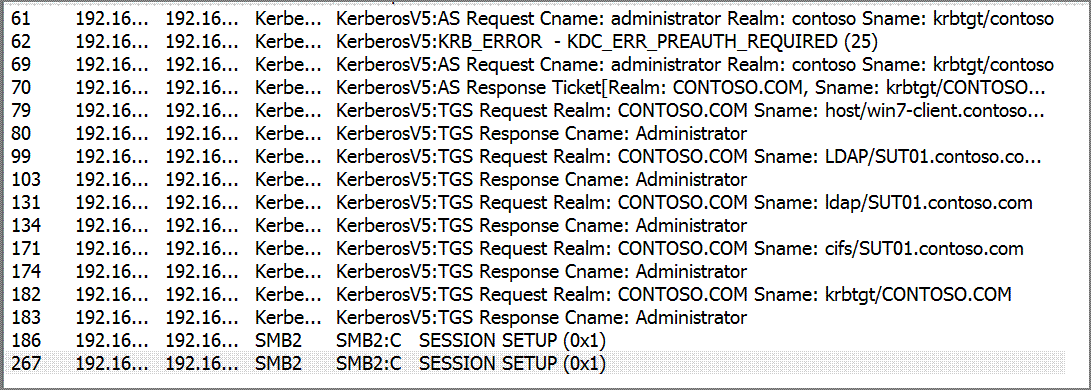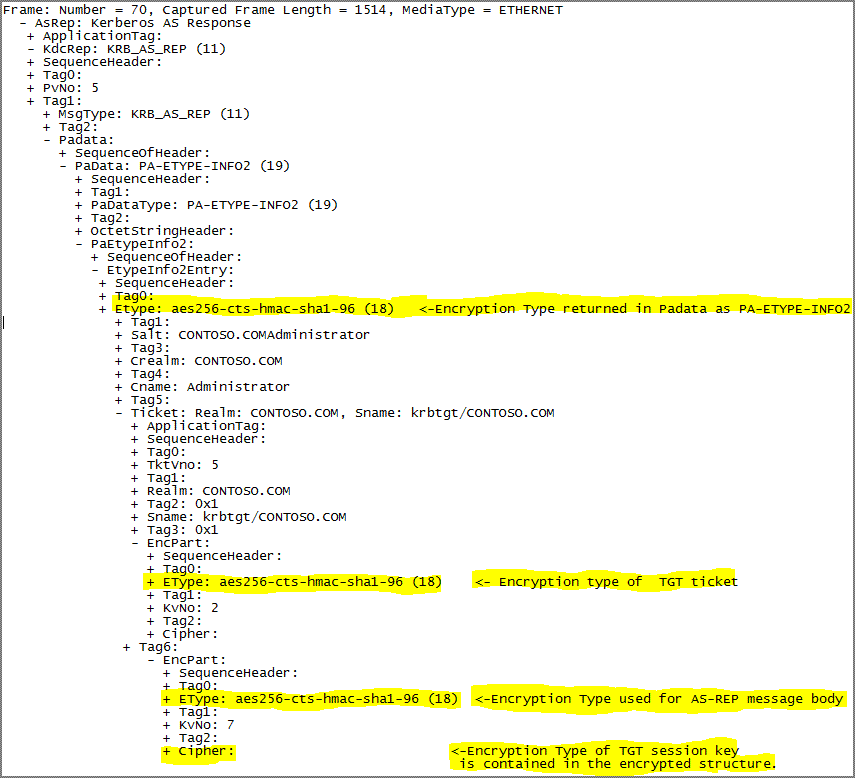Encryption Type Selection in Kerberos Exchanges
The types of encryption used in various Kerberos exchanges are very important and sometime confusing aspects of the Kerberos implementation. We not only need to understand the Kerberos RFC (RFC 4120, RFC 3961 etc) that specifies generally how the encryption types should be selected, but also the effects of Windows Active Directory and registry settings on the selection of encryption types. To make it a little bit more complicated, for most of Kerberos exchanges (AS, TGS and AP), there may be more than one encryption types, which may be selected differently, present in a single request or response.
In this blog, we will take a look at the encryption types in the AS/TGS exchanges of Kerberos, using a typical scenario shown in the network capture. We will show how to find the various encryption types in the network packets and then explain the logics of selecting encryption types by the client and the KDC. This may help the understanding of the connection between protocol details and live network traffic. We have to note that the logics are all documented in the Kerberos RFC (4120) and MS-KILE,the Mircosoft extension to Kerberos V5, we just summarize them here with the sample network packets.
Fig.1 A typical Kerberos exchanges
Basic Structures
Let us first look at some important structures used in all encrypted parts of Kerberos exchanges.
- EncryptedData
Just as documented in RFC 4120, many parts of Kerberos messages, such as authenticator, ticket and encrypted response, contain EncryptedData as the container of arbitrary encrypted data. The fields contain all the information that a recipient needs to decrypt the encrypted data. The following network packet shows the layout of an EncryptedData structure, which is an encrypted part of a AS-REP . Please note that in the fields, KvNo is optional.

- EncryptionKey
The encryptionKey is the on-wire structure of a session key that is used for encryption and decryption. A session key is always a combination of the key type and key values. A session key is sent over the wire between client and server in either tickets or the encrypted parts of exchanges, but never appear clear text on the wire.
AS-REQ (RFC 4120 3.1.1)
This exchange is typically used at the initiation of a log in session to obtain credentials for a Ticket-Granting Ticket (TGT), which will subsequently be used to obtain credentials for other services/servers.
The client sends a request to the KDC for a ticket-granting ticket (TGT) ([RFC4120] section 5.3). The client presents its principal name and can present pre-authentication information. The AS-REQ message is not encrypted except the pre-authentication part if present. If pre-authentication part is required for the user, but it is not present in the AS-REQ, there will be multiple of trips of AS-REQ/AS-REP exchanges until correct form of pre-authentication data is received by KDC or KDC will fail the request. The following is a typical AS-REQ packet with the encryption types highlighted.
Now let us take a look at how the encryption types involved in AS-REQ are selected.
- Etype in AS-REQ message body
This is the list of encryption types in a preference order that the client can support. It is dependent on the cypto systems available on the client . The following is the list of the encryption available for each Windows system
Windows 2000, XP,Windows Server 2003: DES, RC4
Vista , Windows Server 2008: DES, RC4,AES
Windows 7 and Windows Server 2008 R2: DES(disabled by default), RC4,AES
- Encryption Type for PA-ENC-TIMESTAMP in paData
This is the encryption type used for the time stamp in pre-authentication. This is the encyption type used by a client to encrypted paData that will be decrypted by KDC.
If a client sends PA-ENC-TIMESTAMP in paData in the initial AS-REQ, it will use the strongest encryption type with the key available on the client machine.
If a client sends AS-REQ after receiving KDC_ERR_PREAUTH_REQUIRED, it will use the strongest encryption returned in the paData in the AS-REP that returns the error KDC_ERR_PREAUTH_REQUIRED.
AS-REP (RFC 4120 3.1.3)
In AS-REP, KDC returns a TGT and a session key that a client can use to encrypt and authenticate communication with the KDC for ticket-granting service (TGS) requests, without reusing the persistent key. The following are the encryption types involved in AS-REP and their selection criteria.
- Encryption Type used for encrypting AS-REP message body
This is the type of encryption used for AS-REP message body. The KDC selects an encyption type to encrypt the message and the client decrypts the message. In Windows 2000 and Windows Server 2003, the KDC selects the encryption type based on the preference order in the client request. In Windows Server 2008, and Windows Server 2008 R2, the KDC selects the encryption type used for pre-authentication, or, when pre-authentication is not used, the encryption type based on the preference order in the client request[MS-KILE-WBN12]. Certainly the selected encryption type has to be supported by the KDC too.
- Encryption type of TGT ticket
This is the encryption type of the encrypted part of a TGT ticket returned to the client by the KDC. The KDC selects this encryption type to encrypt the TGT ticket and the KDC will decrypt the TGT ticket when the client presents the TGT ticket to request a service ticket in TGS-REQ phase. The client doesn't really need to know how to decrypt TGT ticket. Therefore , KDC just needs to use setting of krbtgt account ,under which the KDC runs, and other settings on DC to select an encryption type for TGT ticket.
If USER_USE_DES_KEY_ONLY of UserAcountControl attribute on krbtgt account is set
KDC’s supported encryption list includes only DES encryption.
Else
If KDC is running on DC before Windows 2008
KDC’s supported encryption list includes RC4 and DES.
Else
KDC’s supported encryption list includes AES, RC4 and DES.
If registry setting KdcUseRequestedEtypesForTickets is 1
KDC will pick the first entry in requested encryption list sent in AS-REQ
Else
KDC will select a strongest encryption from the KDC’s supported encryption list.
Please refer to MS-KILE 3.3.5.3 for more details.
- Encryption Type returned in Padata as PA-ETYPE-INFO2
This is the encryption type the client should use to generate a key to decrypt the encrypted part of the AS-REP message using password in conjunction with the salt value that is also returned in this Padata entry. This has to be supported by both KDC and the client. The KDC sets it to the encryption type that the client uses for the encyption of PA-ENC-TIMESTAMP in Padata in the AS-REQ.
- Encryption Type of TGT session key
The KDC sends the TGT session key in the encrypted part of AS-REP so the client can use it to encrypt the future TGS exchanges to request service ticket. This cannot be observed on the network packet since it is in the cipher part. The KDC and the client should both support this type of the encryption. The KDC selects the strongest common encryption between what the client requests in AS-REQ and KDC’s supported encryption list as determined in the section for selecting the encryption type of TGT ticket.
TGS-REQ (RFC 4120 3.3.1)
In TGS-REQ, The client sends a request to KDC for a ticket for a service. The client presents TGT ticket received in AS-REP , an authenticator and the SPN of the service. The following are the encryption types involved
- Etype list in TGS-REQ message body
This is the list of encryption types the client can support. The logic is the same as the EType in AS-REQ Message Body.
- Encryption type of TGT ticket in TGS_REQ
This is the encryption type of the TGT ticket received in the AS-REP. The encyption and decryption of the TGT ticket are only done by the KDC. The client just forwards the TGT ticket without decrypting it so the encryption type is selected by the KDC in the previous AS-REP.
- Encryption type of authenticator in TGS-REQ
This is the encryption type used for the authenticator. The encryption type has to be supported by both the client and the KDC. The client encrypts the authenticator and the KDC decrypts it. This encryption type is the same as the that of the TGT session key received from the KDC in AS-REP because the client uses the TGT session key to encrypt the authenticator.
TGS-REP (RFC 4120 3.3.3)
While preparing for the TGS-REP, KDC validates the TGT and authenticator. If they are valid , the KDC then returns a service ticket and a session key for further communication between client and server. The following are the encryption types involved:
- Encryption type of the service ticket
This is the encryption type of the encrypted part of a service ticket. The KDC encrypts the service ticket and the server decrypts it. KDC needs to select a strongest common type that can be used by the application server and the KDC. The client will never need to decrypt the service ticket.
The supported encryption types of a server or service that the ticket is issued for are determined as follows:
If USER_USE_DES_KEY_ONLY of UserAcountControl attribute of the service account is set
The supported encryption list contains only DES encryptions.
Else
The supported encryption list is set to msDS-SupportEncyptionTypes plus RC4 and DES.
Since msDS-SupportEncyptionTypes is not present on any computer account before Vista/Windows Server 2008, therefore its supported encryption types are always set to RC4 and DES . If the ticket is for a DC or a krbtgt account with domain functional level > Windows Server 2008 , AES will be automatically added. See section 3.3.5.4 of MS-KILE for the details.
- Encryption type of TGS-REP message
A part of the TGS-REP message itself is encrypted when returned to the client that will in turn decrypt the message. KDC has to pick up an encryption that can be used by both the KDC and the client. The session key used for encrypting TGS-REP message is either the session key in the TGT ticket or the sub-session key in the authenticator, both embedded in TGS-REQ. Therefore, the encryption type used is dependent on the session key used that has the first four bytes as the key type.
- Encryption type of Session Key
The KDC returns a session key for client to encrypt the future AP exchanges between the client and the application server. The same session key is also embedded in the service ticket. The encryption type has to be used by both the client and the application server. The KDC selects the strongest common encryption type between the client’s encryption list present in the TGS-REQ and the server’s supported encryption list as described in the logic for "Encryption type for service ticket".
I hope that the discussion and the network packet samples can help you understand the encryption types involved in the AS/TGS exchanges. The discussion doesn’t cover some other aspects such as the encryption of PAC and forwarded TGT as well as the encryption in AP exchanges, which could be the topic of another blog.
[Reference]
1. RFC 4120 https://www.ietf.org/rfc/rfc4120.txt
2. [MS-KILE] https://msdn.microsoft.com/en-us/library/cc233855(PROT.13).aspx
Comments
Anonymous
June 25, 2012
This is a great article!Anonymous
July 15, 2016
Thank you! Helped a lot.Anonymous
April 02, 2017
I was looking for that in other places but noone did help me. Thanks for that!!! It's useful a lot.Anonymous
June 04, 2017
Thank you, wonderful article!Anonymous
July 17, 2017
The article helped me a lot! Thank you!




